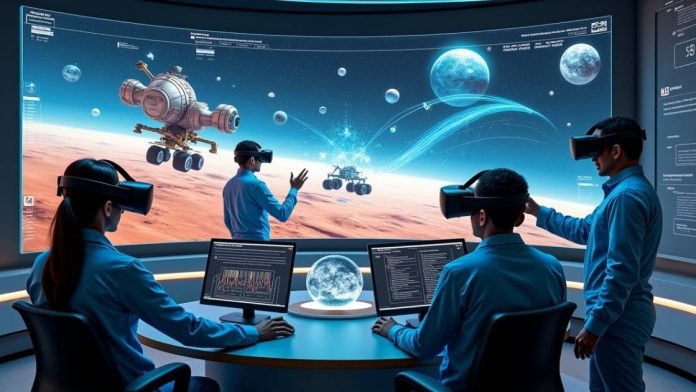The concept of the Metaverse is that of a persistent, immersive virtual environment that has evolved far beyond gaming and social platforms. As space agencies and private companies push the boundaries of space exploration, the Metaverse is emerging as a powerful tool in planning, simulating, and even participating in space missions. From astronaut training to remote operations on Mars, the convergence of virtual reality (VR), augmented reality (AR), and artificial intelligence (AI) is transforming how we reach for the stars.
In this article, we’ll explore how the Metaverse is being used in real-world space applications, what it means for the future of exploration, and why it might be essential for humanity’s survival in space.
What is the Metaverse and Why It Matters in Space?
At its core, the Metaverse is a collective virtual shared space created by the convergence of virtually enhanced physical reality and physically persistent virtual environments. In space exploration, this translates to immersive environments where astronauts, engineers, and scientists can collaborate, simulate, and experiment without the constraints of physical space or distance.
Why the Metaverse Makes Sense for Space:
- Extreme distances: Real-time interaction is impossible between Earth and distant spacecraft due to latency.
- High costs: Launching hardware and running physical simulations is expensive.
- Training needs: Astronauts require extensive preparation for unfamiliar, hazardous environments.
- Remote collaboration: Missions involve international teams working across time zones and continents.
Key Applications of the Metaverse in Space Missions
1. Astronaut Training and Simulation
NASA, SpaceX, and other organizations are increasingly using VR environments to simulate spacewalks, spacecraft operations, and Martian terrain. The Metaverse enables hyper-realistic simulations that allow astronauts to:
- Train for emergency scenarios without physical risk.
- Explore and adapt to alien environments like the Moon or Mars.
- Build muscle memory in zero-gravity virtual settings.
Example: NASA’s Hybrid Reality Lab blends physical mockups with VR simulations, preparing astronauts for International Space Station (ISS) missions in ways traditional methods cannot.
- Mission Planning and Collaboration
Virtual environments allow mission planners and engineers to:
- Visualize spacecraft designs and planetary landscapes.
- Conduct mission walkthroughs in 3D before execution.
- Collaborate across continents in real time within a unified virtual control room.
The Jet Propulsion Laboratory (JPL), for instance, uses mixed-reality tools to analyze Mars terrain and plan rover paths more effectively.
- Remote Robotic Operations
The Metaverse enhances control over remote space robotics such as rovers, drones, and satellites by:
- Offering immersive interfaces for teleoperation.
- Providing predictive modeling through AI simulations.
- Reducing reaction-time delays with pre-programmed VR-assisted paths.
This is especially relevant for missions to the Moon, Mars, or asteroids, where terrain is unpredictable and real-time control is limited.
- Public Engagement and Education
Space agencies are leveraging the Metaverse to spark interest in the cosmos:
- Virtual tours of space stations and simulated Martian colonies.
- Interactive spacewalks and lunar missions open to students and the public.
- Educational platforms like NASA’s Artemis VR for immersive learning.
This democratizes space exploration, making it accessible to people around the world.
- Psychological Support for Long-Duration Missions
Extended space travel, such as missions to Mars, poses mental health challenges due to isolation and confinement. The Metaverse offers:
- Virtual social spaces where astronauts can interact with loved ones or the public.
- Simulated Earth-like environments for psychological comfort.
- Gamified wellness platforms for mental resilience.
Maintaining a sense of presence and community in an immersive space can be a lifeline during multi-year missions.
Challenges and Considerations
While the Metaverse holds great promise, several hurdles remain:
- Bandwidth and connectivity in space are limited.
- Cybersecurity threats must be addressed to prevent breaches in critical systems.
- VR/AR hardware must be space-ready: compact, durable, and low-power.
- Ethical considerations around identity, behavior, and privacy in virtual environments.
Solving these issues is crucial for full Metaverse integration in space operations.
Conclusion
The Metaverse is not just a digital playground, it’s a mission-critical platform for the next era of space exploration. As we reach farther into the cosmos, virtual environments will become essential for training, operations, and even survival. By merging the virtual with the physical, the Metaverse empowers humanity to boldly go where no one has gone before.

